Barb Cycles:
A ride through history | 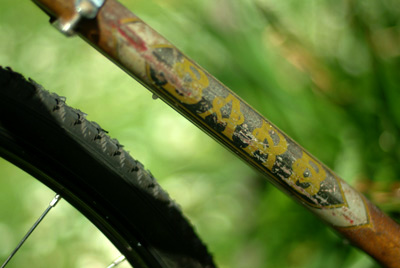 |
During the course of its lifetime, Finlay Brothers would become more widely known for their sales of motorcycles than bicycles.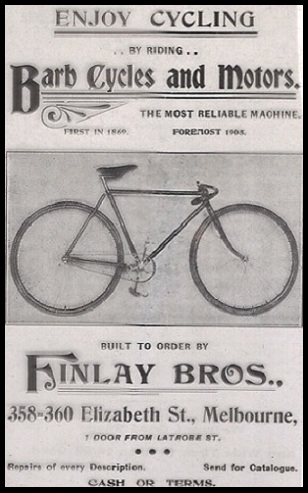
c1905 Private family collection16
|
However, the cycle section of the business was historically significant in a number of ways – including the fact that bicycle building was the very first commercial activity carried out by Finlay Brothers from their Barb Cycle Works in around 1900.1 In addition, bicycles were built onsite, in contrast to the motorcycles which were shipped from overseas pre-assembled in crates.
Barb bicycles were sold by Finlay Brothers from around 1900 until the 1950’s. Some of the firm’s advertising materials indicated that their bicycles may have been built as early as 1897,2 but this has not been substantiated. Barbs are known to have been used competitively in track, road and motor-paced cycling events, as well as by numerous everyday cyclists for transport and recreation – during a period of time when horse and carriage use were progressively overtaken by the car. In choosing the name “Barb Cycles”, the Finlay Brothers firm was making a direct reference to the velocipede which won an early Victorian bicycle race in 1869 (possibly Victoria's first bicycle race) on the Melbourne Cricket Ground.3 This velocipede – called “The Barb” – had been built and ridden by James Finlay, the father of the Finlay brothers. By trade a blacksmith, James Finlay became one of Melbourne’s earliest cycle builders, when reports of a two-wheeled pedal-driven vehicle were filtering across to Australia from overseas.4 He is known to have favoured an American style of velocipede design,5 with a family recollection being that he used gun barrels in the construction of “The Barb”. 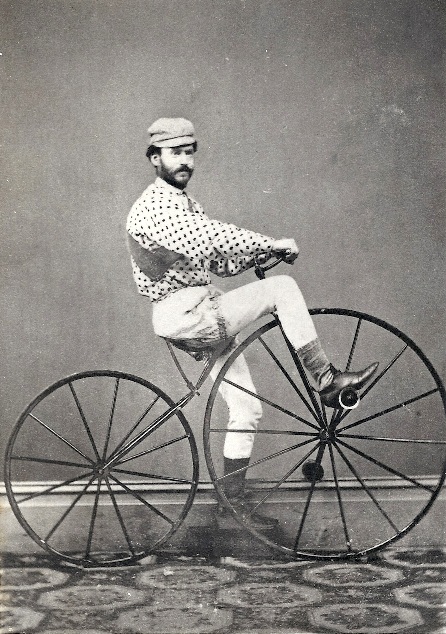
James Finlay on The Barb in 1869
Source: Museum Victoria
|
However, the name of “The Barb” can be traced even further back in history, with a family tale being that James Finlay had actually named his velocipede after the 1866 Melbourne Cup winning horse – “The Barb”. It is also recalled that he wore that jockey’s colours of black and gold for his ride in the bicycle race.
Three of James Finlay’s sons were instrumental in setting up the Finlay Brothers business – Charles, Albert and Robert (Bob). Certainly within the first few years of opening they were producing a range of bicycle designs as well as a printed catalogue. By 1909, four different bicycle models were advertised in numerous country newspapers:
Model Special for £15
Model 2 for £12 10s
Model 3 for £10
Model 4 for £8 10s6 The search for bicycle sales in country areas of Victoria led to Finlay Brothers advertising for country agencies. At one stage, they advertised that as a "special offer", their agents would be given a free bicycle.7 “Rosenthal's” shop in Mildura was a rural store that operated as a country agency for Finlay Brothers’ bicycle around 1910 – advertising as Rosenthal’s Barb Cycle Depot. This shop appears to have been quite diversified, selling sporting, electrical and cycle products.8 They advertised prolifically, and appear were instrumental in the running of local events such as the Barb Road Race of 1914.9 It is likely that numerous country agencies operated throughout rural Victoria. It is thought that the R.J Conroy dealership in Bendigo serviced that area, certainly during the 1940’s. This network enabled country customers to purchase their Barb bicycles locally. During this early period of business growth, it is thought that Bob Finlay (the younger of the brothers) was competing and becoming known as a highly successful Victorian cyclist.10 He was certainly known as a “pace follower” (referring to motor-paced cycling). Finlay Brothers applied to register some of his cycle designs, and he is thought to have designed and built pace bicycles. 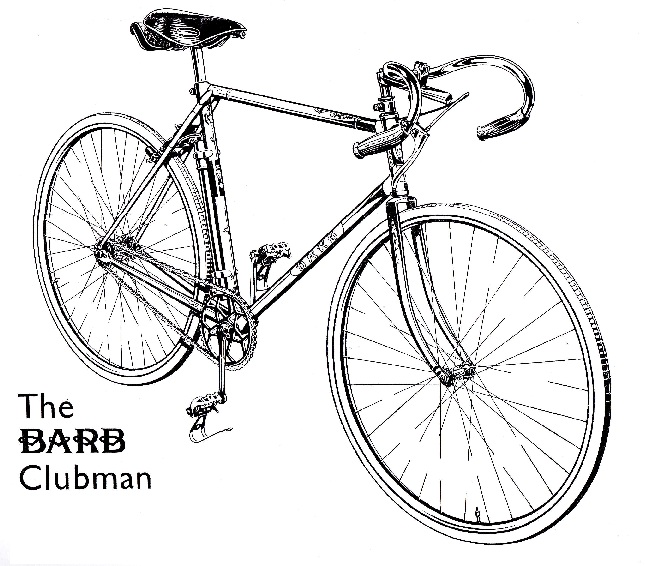
1930's Catalogue17
Courtesy of Warren Meade | |
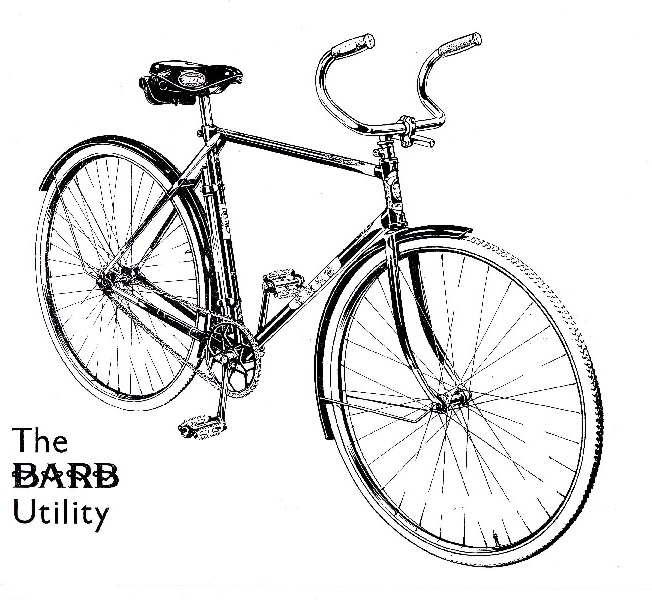 |
A catalogue of Barb models for sale during the 1930’s shows designs such as the Clubman (a premium sports model), Utility, Roadster and Sports.11
One of the specific bicycle designs that Finlay Brothers became known for, was the “Sprung Frame Barb” – a bicycle with a rear suspension mechanism. This bicycle was advertised mainly over the period 1945 to 1947. Barb bicycles were built within the Cycle Department of Finlay Brothers – located on the first floor of the Workshop (a building to the rear of the Elizabeth Street showroom). Pinstriping of the frames was carried out on the second floor of the Workshop. An interesting recollection of a past employee is that the Cycle Department took up about half of the first floor area.12 Also, that of the 40 staff in the Workshop, 7 were based in the cycles area.13 This is significant in view of the fact that motorcycle sales would have far exceeded bicycle sales during this period (late 1940’s onward) – and indicates that quite a substantial volume of bicycles must have been still being produced during this period. Retrospectively, it is noticeable that Barb bicycle advertising of the 1940’s focuses on the lifestyle advantages of owning a bicycle – such as using one for quick trips to the grocery store, or giving one to a child for recreation – rather than for purely utilitarian usage. Models of the 1940’s included Roadsters, Ladies, Sports and Juveniles.14 Toward the end of their years of manufacture, it is thought that Barb production may have been outsourced to an outside company. Finlay Brothers also acted as agents for Sunbeam bicycles.15 Barb production probably ceased by the mid 1950’s, after more than 50 years of cycle building by the company. In essence, Barb Cycles began in 1900 as a way for people to purchase a simple method of transport. In their 50 years of production, the advent of the car and motorcycle meant that the bicycle’s role on the road changed irrevocably. Throughout their history, however, fascinating glimpses show us much of Victoria’s early manufacturing and commercial life - and the struggles of the small family businesses who sought to adapt to the challenges. Therefore, the story of Barb Cycles is really a tale of much wider dimensions than simply its pivot – the bicycle.
.JPG)
A 1934 Barb bicycle |
References: 1. Sands and McDougall, "Melbourne Directory 1900", Public Record Office of Victoria - Microfilm. 2. Mornington and Dromana Standard (Vic:1908-1911), December 25, 1909, 3.
http://nla.gov.au/nla.news-article70086973 3. “Athletic sports on the Melbourne Cricket Ground”, The Argus (Melbourne, Vic.: 1848-1956), July 12, 1869, 6.
http://nla.gov.au/nla.news-article5821039 4. The Argus (Melbourne, Vic.: 1848-1956), June 22, 1869, 5.
http://nla.gov.au/nla.news-article5832508 5. See note 4 above. 6. Mornington and Dromana Standard (Vic:1908-1911), December 25, 1909, 3.
http://nla.gov.au/nla.news-article70086973 7. Mornington Standard (Frankston, Vic: 1911-1920), April 22, 1911, 1.
http://nla.gov.au/nla.news-article65846263 8. The Mildura Cultivator (Vic: 1888-1920), January 8, 1910, 8.
http://nla.gov.au/nla.news-article74859419 9. The Mildura Cultivator (Vic: 1888-1920), April 15, 1914, 8.
http://nla.gov.au/nla.news-article75233256 10. The Mail (Adelaide, S.A: 1912-1954), June 19, 1915, 21. http://nla.gov.au/nla.news-article59298739 11. Finlay Brothers, For Outstanding Value... Barb Cycles, catalogue from the 1930's - this copy issued in 1935 (Melbourne: McCarron, Bird & Co). Courtesy of Warren Meade. 12. Keith Gales, unpublished memoirs (2010), pp5-6 of Chapter 2. 13. Keith Gales, personal communication, November 1, 2012. 14. The Argus (Melbourne, Vic: 1848-1956), December 15, 1945, 15s.
http://nla.gov.au/nla.news-article12158772 15. The Argus (Melbourne, Vic: 1848-1956), July 6, 1946, 31s. http://nla.gov.au/nla.news-article22323439 16. c1905 Printer's negative for a Finlay Brothers advertisement.
17. See note 11 above. |